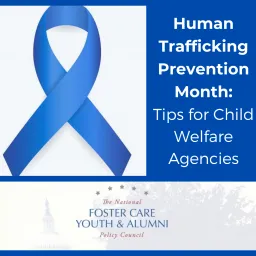“Just help the foster youth to understand that they deserve to be treated appropriately and that people are there to listen.” – former foster youth
January is National Human Trafficking Prevention Month. Youth involved in the child welfare system are particularly vulnerable to becoming victims of human trafficking. The experiences that youth in foster care often face such as unstable housing, isolation from friends and family, and a lack of supportive services while in care increase their chances of being targeted by traffickers who are seeking children to exploit1.
Beginning in 2012, The National Policy Council of Foster Youth and Alumni prioritized the prevention of human trafficking in foster care through the “Reducing Vulnerability of Foster Youth to Predators and Sex Trafficking” priority, which was distributed among policymakers and child welfare stakeholders nationwide. This priority, written by former foster youth, helped to reshape the conversation from one focused on rehabilitating foster youth after experiencing trafficking, to one focused on addressing the vulnerability of foster youth to be trafficked and how to prevent it.
2014’s Preventing Sex Trafficking and Strengthening Families Act included many of the solutions elevated by the Council. The Council also issued an accompanying statement after the Act’s passing, encouraging stakeholders in the field to partner with youth and incorporate their voice into their policy implementation processes.
For National Human Trafficking Prevention Month, the National Policy Council of Foster Youth and Alumni is amplifying our past priorities that we believe will help prevent human trafficking among youth in foster care, as well as provide new data and resources for child welfare agencies.
From 2012’s Reducing Vulnerability of Foster Youth to Predators and Sex Trafficking:
- Educate us about why and how these experiences impact (and will continue to impact) our lives. We must ensure foster youth know that simply being in care can leave them more vulnerable to human trafficking, especially if they run away or age out of the system without finding permanence.
- Give us more ready access to therapy. Ensure services are trauma informed and address sexual abuse.
- Train foster parents to help them care for vulnerable youth. Discussion about prudent parenting and the right to normalcy should be discussed during placement decisions so that foster youth are placed in families that are able and willing to respond to their needs.
- Provide us with mentors and peer support groups — people we can trust. Foster youth cultivate meaningful connections by participation in extracurricular and other activities, and oftentimes have to give up activities they are involved with, including sports or religious commitments.
- Require more in-home visits, some of which should be surprise visits.
From 2014’s Implementing Public Law 113-183:
- Make sure we know our rights and resources, as well as where to turn for help if we are approached by someone wanting to exploit us. Provide a youth-friendly, anonymous resource for reporting abuse.
- Include a youth-friendly grievance process with every list of rights that is distributed to us. Foster youth need multiple opportunities to report any violation of rights and feel safe in doing so. Requiring youth rights serves no purpose if youth have no way to report it.
- Include us in developing our case plans, as well as prudent parenting guidance for foster parents.
Here's some recent resources for child welfare agencies to prevent human trafficking in foster care:
- Human Trafficking and Child Welfare: A Guide for Child Welfare Agencies from the Children’s Bureau
- Human Trafficking and Child Welfare: A Guide for Caseworkers from the Children’s Bureau
- National Advisory Committee on the Sex Trafficking of Children and Youth in the United States: Best Practices and Recommendations for States
- Family First Prevention Services Act: High Quality Service Standards for Specialized Settings: Key Considerations for Developing Residential Programming for Survivors and Young People at Risk of Sex Trafficking
- National Human Trafficking Prevention Month: Resources for Social Service Providers from the Administration of Children and Families
- Training for providers: Responding to Human Trafficking Through the Child Welfare System
- Podcast: The Imprint’s Sex Trafficking Exception
1 Administration for Children and Families. (2017). “Human Trafficking and Child Welfare: A Guide for Child Welfare Agencies”. US Department of Health and Human Services. https://www.childwelfare.gov/pubPDFs/trafficking_agencies.pdf

